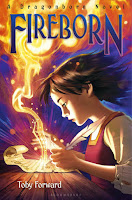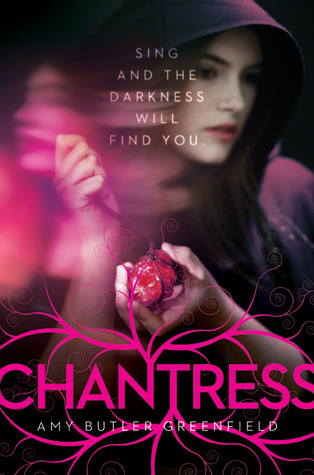We're delighted to welcome Nancy Werlin to the Inkpot today! A gifted writer and teacher, Nancy has won many awards, including an Edgar and a National Book Award honor. Her first YA fantasy novel, IMPOSSIBLE, was a New
York Times bestseller. She’s here today
to talk about the sequel to IMPOSSIBLE, a wonderful new novel about the Scarborough
family: UNTHINKABLE (Penguin/Dial, September 2013).

Fenella
was the first Scarborough girl to be cursed, hundreds of years ago, and she has
been trapped in the faerie realm ever since, forced to watch generations of
daughters try to break this same faerie curse that has enslaved them all. But
now Fenella’s descendant, Lucy, has accomplished the impossible and broken the
curse, so why is Fenella still trapped in Faerie?
In her desperation, Fenella makes a deal with the faerie queen: If she can
accomplish three acts of destruction, she will be free, at last, to die.
What she doesn't realize is that these acts must be aimed at her own family and
if she fails, the consequences will be dire, for all of the Scarborough girls.
How can she possibly choose to hurt her own cherished family not to mention the
new man whom she’s surprised to find herself falling in love with? But if she
doesn’t go through with the tasks, how will she manage to save her dear ones?
Hi, Nancy! Can you tell us what inspired you to write this companion
novel to IMPOSSIBLE?
I kept thinking about the Scarborough Girls in IMPOSSIBLE
and especially the first one, Fenella. To write about her meant a prequel, yet
there was no way that a prequel could end well, since Fenella's history was
already set. Then I thought: What if the prequel were also a sequel, set in
modern times? What is Fenella had not only a past, but a future?
Writing a character who must climb out of her own despair
was so compelling. There was nothing wrong with Lucy Scarborough except the
curse on her family; Lucy fights for her future because she believes in it and
in herself.
But Fenella is dark to Lucy's light. She looks inside and
sees emptiness. She looks ahead and sees nothing. The nature of the
suicide is to be blind.
But I knew Fenella should not throw away her life. It is
precious. She is precious.
I wanted Fenella to learn to throw her arms open to her future. To embrace the
miracle of life. This is not an easy road for a suicidal person. But it is not
impossible. And the first step — as the Faerie Queen knows in Chapter 1 — is
simply being forced to engage with life in all its messiness and unfairness, in
all its love and possibility.
At the start of UNTHINKABLE, Fenella is deeply
isolated, and part of what’s so gripping about this book is watching her
grapple with the many new relationships she forms in her new life – with the
Scarborough-Markowitz-Greenfield clan, with Walker Dobrez, even with Ryland the
cat. Which relationship did you most enjoy writing about? Which one was
the most challenging?
I need to feel what my character feels, in order to write.
Fenella is tortured. She needs desperately to maintain her distance from Lucy,
Zach, and the Markowitzes; she needs not to love them; so that she can
save them and end herself. Rough going. It was especially difficult to write
the scene when Fenella tries to seduce Zach, in order to destroy his and Lucy's
marriage.
But I will add that, for a writer, it is also extremely
rewarding to dare such scenes, to write what I need to write.
There were delightful scenes, too, such as the ones with
Fenella and Walker Dobrez — she is shocked to be attracted to him, because
isn't she dead inside? Also, there is cynical Ryland, a nasty faerie
prince in disguise as a cat. He snipes at Fenella in her head -- and she
dresses him in baby's clothes, including a sunbonnet.
Finally, there is Minnie Scarborough, who we meet only in
Fenella's memories. Minnie is a Scarborough Girl who studied nursing after the
American Civil War, and was the first feminist that Fenella ever met. I was so
relieved to discover that Fenella had loved and been loved by Minnie ... that
her heart had not been entirely desolate for four hundred years.
Fenella Scarborough was born 400 years ago, but
for most of that time she’s been a captive, kept far away from mortals – until
UNTHINKABLE begins and she’s sent to present-day Massachusetts. I loved
being able to look at the world through Fenella’s eyes—and to see her respond
to the possibilities she now has as a 21st-century American
woman. Did writing the book make you appreciate those possibilities, too?
This question reminds me of an incident from when I was in
college. A dreamy classmate asked several of us: "If you could choose any
period of history in which to live, which would it be?"
I didn't have to think twice: "No woman in her right
mind would ever want to live in the past!"
Fenella emerges into a world where she can be herself in a
way that was not possible in the 17th century. She surprised even me when she
climbed into a truck and wanted to drive it — and then to look under the hood — and then to invent an engine! She discovers that her curiosity and her
interests and her ambition cannot be repressed, not once she is forced to
engage with the world.
We humans are resilient, even when we don't want to
be.
 |
| (Credit: Jerry Bauer) |
Can you talk a bit about the process of writing
UNTHINKABLE? How much revision did you need to do? And how did you
know when you were done?
The first drafts went slowly, as I tried to figure out the
tasks of destruction and how Fenella would handle them, and also to keep the
complicated relationships and plot strands straight. I spent a long time
working on my first three chapters, set in Faerie. Then, in the rest of the
book, there were so many characters and I had to figure out who needed to be
emphasized when — and who needed to be cut. There were long talks with my
draft readers and some late discoveries — such as the realization that Fenella
was deeply afraid of Lucy's baby, and those feelings related to her having
failed her own daughter — that needed to be worked into the plot.
It was laborious, but I knew I was done when — about a
year after my initial deadline — I felt a great big internal YES as I
read.
I am so proud of this difficult book.
What is your favorite scene?
Ah, easy! Fenella is a healthy 17th century woman, and she
is as straightforward as Shakespeare in her sexuality. Her love scene with
Walker is the first full sex scene I've ever written in a novel, and I loved
writing it.
Thanks so much for talking about the process of writing UNTHINKABLE, Nancy! We're glad you stopped by.
***
Interview by Amy Butler Greenfield, who was on her way to a history Ph.D. when she gave into temptation and
became a novelist. Now an award-winning writer, she lives with her family in England, where she eats chocolate, bakes cakes, and plots mischief. Her most recent book is the YA historical fantasy CHANTRESS (McElderry / S&S, 2013). You can find her at www.amybutlergreenfield.com.
 This fall, middle grade fantasy covers are calling us to the
light. Usually, it’s a blazing sky with one or more heroes either hurling
themselves into it or running for their lives. But who can say no to flashes of
lightning, glowing gizmos, or good old-fashioned magical energy?
This fall, middle grade fantasy covers are calling us to the
light. Usually, it’s a blazing sky with one or more heroes either hurling
themselves into it or running for their lives. But who can say no to flashes of
lightning, glowing gizmos, or good old-fashioned magical energy? This fall, middle grade fantasy covers are calling us to the
light. Usually, it’s a blazing sky with one or more heroes either hurling
themselves into it or running for their lives. But who can say no to flashes of
lightning, glowing gizmos, or good old-fashioned magical energy?
This fall, middle grade fantasy covers are calling us to the
light. Usually, it’s a blazing sky with one or more heroes either hurling
themselves into it or running for their lives. But who can say no to flashes of
lightning, glowing gizmos, or good old-fashioned magical energy?






















.jpg)







